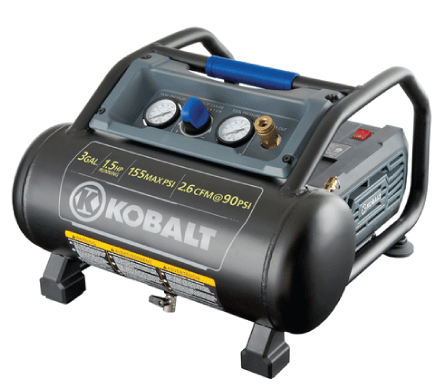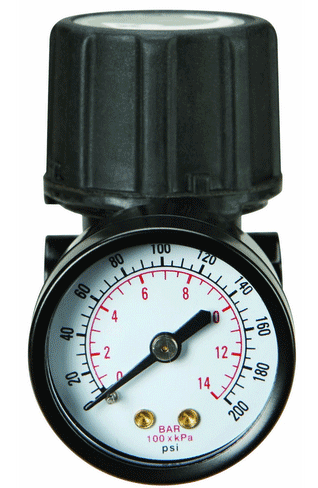A common complaint of small air compressor owners is… “I need more air” out of my air compressor.
There reasons why a particular air compressor will not deliver enough air, and there are some things that you can do to get more air volume and flow from your air compressor.
It will help for you to recognize that for each horsepower of electric compressor motor you will generate around 4 CFM of compressed air at 90 PSI. If you are tool consumes way more than that, then likely you saying “I need more air” from your air compressor won’t accomplish anything. Here’s why.
Mismatched Air Tool & Air Compressor
For purposes of example, let’s say you have a 1.5 HP DIY home air compressor similar to the little Kobalt compressor shown below.
That compressor, assuming you have it in optimal condition, with an excellent 20 amp breaker in the circuit, with no other appliances pulling any power from the same circuit when the compressor is starting or running, and you are not using an extension cord or power bar is, in theory, capable of providing a flow of 3-6 CFM of air at 90 PSI.
In actuality Kobalt themselves will only promise 2.6 CFM at 90 PSI from their air compressor shown below. So much for the theory that says you can get about 4 CFM of compressed air at 90 PSI for each HP of compressor motor!

Let us also say that you are of the opinion that since you now have an air compressor that works just fine, that you now can run any air tool with the compressed air from your air compressor. Let’s have a look at this air tool, for example.
You have an air compressor. It pumps air into the air line to the sand blast gun. You attach the sand hose and drop the suction end into your bag of sand, pull the trigger on the sand blast gun and… you get a dribble of sand, maybe a small blast of sand, your air compressor starts almost immediately, and no matter how hard you pull on the sand blast gun trigger, the darn think won’t blast the paint or rust off your project. Dang!
This is a classic air tool to compressor mismatch.
The compressed air demand of a typical sand blast gun is huge. The air compressor sown above will deliver 6 CFM if all is optimal, and, typically, 6 CFM won’t run a sand blast gun too long, for sure.
Now, if you had a 30 gallon tank full of pre-compressed air, even with a small air compressor pump like the one above on it, you could blast sand for a few minutes until you used all the air in the tank, and then you would have to wait a long time for the small air compressor pump to drive enough air into the big tank to have a reservoir of compressed air again.
In other words, mismatching the air compressor and the air tool will only result in you becoming discouraged and unhappy with the result, even though both the air compressor and your air tool are working properly.
If you try to run a high-demand air tool with a too small air compressor, they mismatched combination will not work and there will be little you can do to run an air tool that requires tons more air than your compressor can deliver.
I Need More Air – What To Do?
If your air tool demand exceeds the supply flow capacity of your air compressor, then in order to get a greater volume of air to the tool, one thing you can do is dial down the air pressure.
The compressor pictured above can deliver about 3 CFM at 90 PSI. What would happen the supply of air from this same air compressor if you were using air at 30 PSI or 40 PSI instead of the 90 PSI that the air compressor can deliver?
Since the pump can produce air at 90 PSI at about 3 CFM, that’s what is going into the tank. If you are pulling air out at 30 or 40 PSI, then the air in the tank will last longer. Depending on the air tool you are using, this may make the difference between being satisfied that the air tool can do the job, or annoyed because the air compressor and air tool combination will not work properly.
Reducing the Air Pressure
To reduce the air pressure to your air tool you would need to adjust the air regulator that is supplying the air flow to the discharge coupler on your air compressor. You do this by turning the knob on the air regulator, and watching the air regulator gauge. The needle on the air regulator gauge (make sure you are looking at the air regulator gauge as air compressors typically have two air gauged) displays the pressure setting that will be delivered to the discharge coupler of the air compressor, even though the air coming into that regulator from the compressor tank will be at 90 PSI. Here is what your regulator might look like.

Or, your air compressor may have a panel mount regulator gauge and all that you can see of the regulator itself is the adjusting knob, similar to the blue knob on the compressor regulator on the Kobalt air compressor in the photo at the top of this page.
You still need more air to use your air tool? Then… add another air tank.


Instead of using 90 PSI compressor, when the requirement is only say 40 PSI, can we not get compressor designed to deliver air at 40 PSI. so that the CFM per HP can be increased significantly.
Interesting thought. Yet, when you dial down your compressor regulator to 40 PSI, and the tank has 90 PSI in, you are actually emulating what you are suggesting. A tank full of air at 90 PSI will flow longer at 40 PSI before cut in than if the regulator was set for 90 PSI. If, at 40 PSI from a 90 PSI tank, your compressor cannot keep up with your air tool, then your air compressor capacity is too little for that air tool demand.